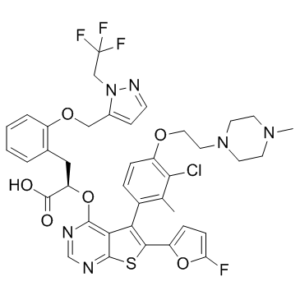S63845
This product is for research use only, not for human use. We do not sell to patients.

For small sizes, please check our retail website as below: www.invivochem.com
| Size | Price | Stock |
|---|---|---|
| 100mg | $1900 | Check With Us |
| 200mg | $2850 | Check With Us |
| 500mg | $4800 | Check With Us |
Cat #: V2797 CAS #: 1799633-27-4 Purity ≥ 98%
Description: S63845 is a potent, selective and high affinity small molecule inhibitor of MCL1 (myeloid cell leukemia 1) with Ki value < 1.2 nM.
Top Publications Citing Invivochem Products
Publications Citing InvivoChem Products
Product Promise

- Physicochemical and Storage Information
- Protocol
- Related Biological Data
- Stock Solution Preparation
- Quality Control Documentation
| Molecular Weight (MW) | 829.26 |
|---|---|
| Molecular Formula | C39H37ClF4N6O6S |
| CAS No. | 1799633-27-4 |
| Storage | -20℃ for 3 years in powder formrrr |
| -80℃ for 2 years in solvent | |
| Solubility In Vitro | DMSO: ≥ 100 mg/mLrrr |
| Water: <1mg/mLrrr | |
| Ethanol: <1mg/mL | |
| SMILES Code | O=C(O)[C@@H](CC1=C(OCC2=CC=NN2CC(F)(F)F)C=CC=C1)OC3=C4C(SC(C5=CC=C(F)O5)=[C@@]4 [C@@]6=C(C)C(Cl)=C(OCCN7CCN(C)CC7)C=C6)=NC=N3. |
| Synonyms | S-63845; S 63845; S63845; Exact Mass: 828.212 Chemical Name: (R)-2-((5-(3-chloro-2-methyl-4-(2-(4-methylpiperazin-1-yl)ethoxy)phenyl)-6-(5-fluorofuran-2-yl)thieno[2,3-d]pyrimidin-4-yl)oxy)-3-(2-((1-(2,2,2-trifluoroethyl)-1H-pyrazol-5-yl)methoxy)phenyl)propanoic acid |
| Protocol | In Vitro | The pro-survival protein myeloid cell leukemia 1 (MCL1) is over expressed in many cancers. S63845 is a small molecule that specifically binds with high affinity to the BH3-binding groove of MCL1. S63845 potently kills MCL1-dependent cancer cells, including multiple myeloma, leukaemia and lymphoma cells, by activating the BAX/BAK-dependent mitochondrial apoptotic pathway. The activity of S63845 is next evaluated in a panel of eight AML cell lines: all lines are sensitive to S63845 (IC50=4-233 nM). |
|---|---|---|
| In Vivo | S63845 shows potent anti-tumour activity with an acceptable safety margin as a single agent in several cancers. Intravenously injected (i.v.) S63845 exerts dose-dependent anti-tumour activity in human multiple myeloma (H929 and AMO1) xenografts in immunocompromised mice, with maximal tumour growth inhibition of 114% in the AMO1 model and 103% in the H929 model. At 25 mg/kg, S63845 induces complete regression in 7 out of 8 of the mice at 100 days after treatment in the AMO1 model. |
These protocols are for reference only. InvivoChem does not
independently validate these methods.
| Solvent volume to be added | Mass (the weight of a compound) | |||
|---|---|---|---|---|
| Mother liquor concentration | 1mg | 5mg | 10mg | 20mg |
| 1mM | 1.2059 mL | 6.0295 mL | 12.0589 mL | 24.1179 mL |
| 5mM | 0.2412 mL | 1.2059 mL | 2.4118 mL | 4.8236 mL |
| 10mM | 0.1206 mL | 0.6029 mL | 1.2059 mL | 2.4118 mL |
| 20mM | 0.0603 mL | 0.3015 mL | 0.6029 mL | 1.2059 mL |
The molarity calculator equation
Mass(g) = Concentration(mol/L) × Volume(L) × Molecular Weight(g/mol)
Mass
=
Concentration
×
Volume
×
Molecular Weight*
The dilution calculator equation
Concentration(start)
×
Volume(start)
=
Concentration(final)
×
Volume(final)
This equation is commonly abbreviated as: C1 V1 = C2 V2
Concentration(start)
C1
×
Volume(start)
V1
=
Concentration(final)
C2
×
Volume(final)
V2
Step One: Enter information below
Dosage mg/kg
Average weight of animals g
Dosing volume per animal µL
Number of animals
Step Two: Enter the in vivo formulation
%DMSO
+
%
+
%Tween 80
+
%ddH2O
Calculation Results:
Working concentration:
mg/ml;
Method for preparing DMSO master liquid:
mg
drug pre-dissolved in
µL
DMSO(Master liquid concentration
mg/mL)
,Please contact us first if the concentration exceeds the DMSO solubility of the batch of drug.
Method for preparing in vivo formulation:
Take
µL
DMSO master liquid, next add
µL
PEG300, mix and clarify, next add
µL
Tween 80,mix and clarify, next add
µL
ddH2O,mix and clarify.
Note:
- (1) Please be sure that the solution is clear before the addition of next solvent. Dissolution methods like vortex, ultrasound or warming and heat may be used to aid dissolving.
- (2) Be sure to add the solvent(s) in order.




































